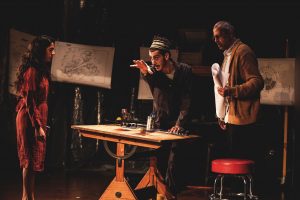
Near the end of his oral dissertation on the arc of misinformation and propoganda in America, Josh Fox makes a concluding statement. “We are the first generation to know what the global apocalypse will look like.” Your proclivity to agreeing with that idea will inform your affinity to The Truth Has Changed.
When listening to one sided downloads of information, I try to maintain a healthy degree of skepticism. The terrain covered in Mr. Fox’s monologue is quite large. His opinions are thoughtful and unabashedly liberal. His ability to communicate outrage is extremely effective. This is a personal story and a frighteningly universal one. I felt the weight on my shoulders by the end. These are heavy times.
“How do we know what’s true?” That’s the simple question which starts this account. Josh Fox is a famous documentary filmmaker and activist. He begins by discussing frackers coming to the Delaware River, the source of much drinking water in our area. He made a film Gasland in 2010 focusing on impacts felt in communities where hydraulic fracturing was taking place.
Fracking releases hydrogen sulfide and methane gas. Since that is not a naturally occurring event, rational minds might want to understand the side effects. Seems a logical question to ask. Mr. Fox did that and filmed conversations with people across their kitchen table. A scratchy feeling going down a man’s throat. Nine stillborn calves. His documentary would win a Sundance Film Festival prize and receive an Academy Award nomination.
The most riveting part of The Truth Has Changed is recapping what happened after film was released. The oil media machine’s 721 page hit sheet refuting the film. Death threats. Ecoterrorists burning down his parent’s shed. A conclusion that Gasland was “propoganda that the Nazi Goebbels would be proud of.” Q&A segments on Fox News editing and misappropriating his words. Then, a sad realization that the government started buying into the hyperbole; notably, Obama, Biden and Hillary Clinton.
Misinformation is not a new strategy in America. Mr. Fox makes this history clear. Lying about the weapons of mass destruction used to sell the Gulf War. A faked Gulf of Tonkin incident which allowed President Johnson to expand the Vietnam War. The Sedition Act of 1918 which enabled the government to incarcerate Eugene Debs for speaking out against World War I. His views are crystal clear: “war is always sold as a lie.”
This jam-packed information download moves from the oil wars to environmental concerns. He viewed the BP oil spill in the Gulf of Mexico from the air despite the FAA’s initial blockade. The scale was immense. His commentary: “if they can cover up the greatest environmental disaster in the U.S., what chance does the truth have?”
Climate change is extensively discussed in The Truth Has Changed. Steve Bannon and Cambridge Analytica’s activities resulting in Facebook posts spreading misinformation using your personal pyschographics. The spreading of fear in “supersized kaleidoscopic doses.” A fueling of stochastic terrorism which is the public demonization of a person or group resulting in the incitement of a violent act. In our twitterverse, this is a wholly believable evaluation of America right now.
As a theatrical experience, Josh Fox weaves a lot of information into a very full but ultimately digestible download. Personal stories resonate best since they are fresh information to consume. There are a lot of teaching moments which occasionally feel like classroom lecturing. If you are interested in finding some truths – or at least challenging your beliefs – this show has much to offer. My attention was held throughout.
The oil industry is “using the DNA of the last mass extinction to fuel the current one.” This show is depressing. Josh Fox, however, is pushing for change. “Change is truth.” His plea? “Dive in.” As Australia burns these past weeks, why is it that science is under attack? The only explanation I can get my head around is corporate profits and short-term greed. The truth has indeed changed. What’s next?
The Truth Has Changed is part of the Under the Radar Festival at The Public Theater. The last performance is January 19, 2020. The show will be performed at Miami Dade College from March 12-22, 2020.



You must be logged in to post a comment.